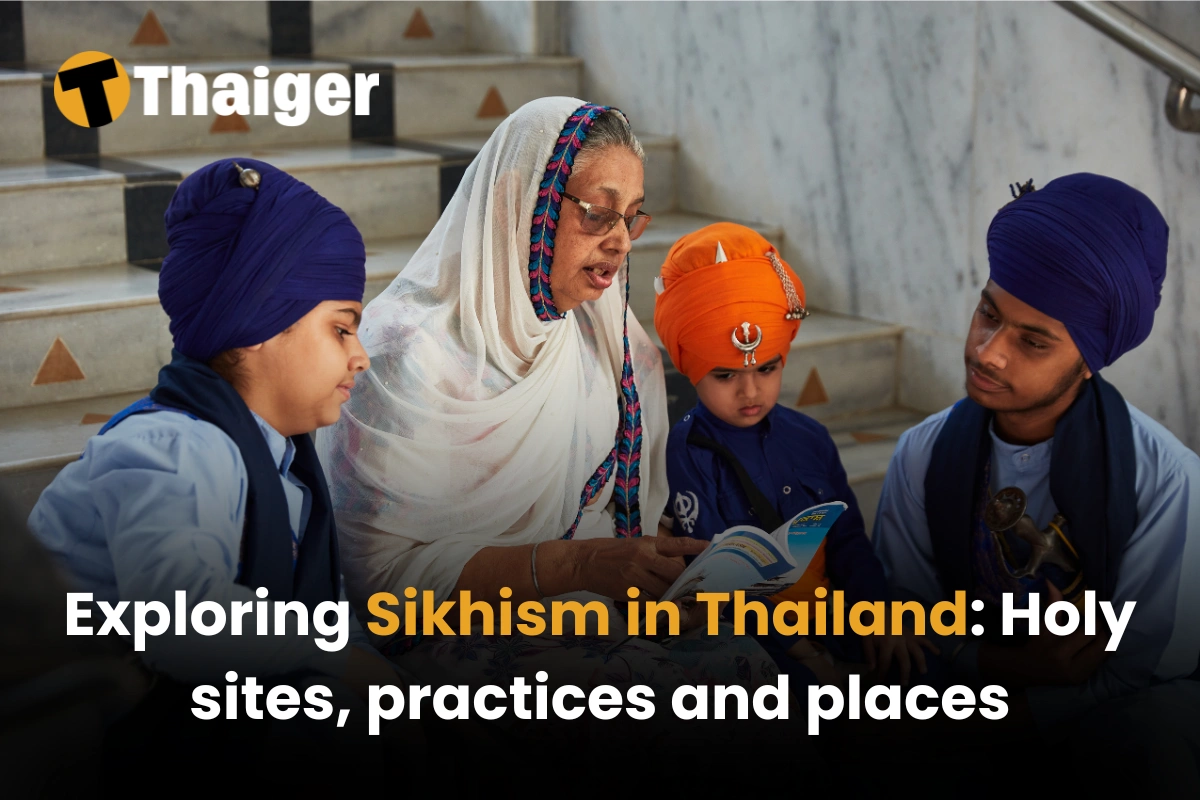Exploring Sikhism in Thailand: Holy sites, practices and places

Sikhism in Thailand is a unique blend of faith, culture, and community, deeply integrated into the country’s diverse society. With a history dating back to the 19th century, the Sikh community has built strong traditions, sacred places, and meaningful celebrations that reflect their rich heritage. This article explores the key sites, practices, and cultural contributions of Sikhism in Thailand, offering insight into this community’s vibrant role in Thailand’s cultural landscape.
The presence of Sikhism in Thailand

A brief history and growth
Sikhism in Thailand began in the late 19th and early 20th centuries when Sikh migrants from Punjab arrived in search of new opportunities. Many came as soldiers and guards under British influence, while others ventured into textile trading and business. These early settlers established a strong community, with Bangkok becoming the centre of Sikh life. By 1911, they held religious gatherings in homes, which eventually led to the opening of the first gurdwara in Bangkok in 1913.
Demographics and cultural identity
The Sikh community in Thailand, numbering around 70,000 people, has developed a unique cultural identity that combines their religious traditions with Thai society. While most Sikhs live in urban areas such as Bangkok, Chiang Mai, and Phuket, they have successfully integrated into Thai life while preserving their distinct customs. A common practice among younger Sikhs is adopting Thai names alongside their Sikh names, making it easier to interact with the local population and navigate government systems. This reflects their efforts to balance their cultural roots with their Thai identity.
Sikhs make up about 0.08% of Thailand’s population and are recognised as a religious minority by the Thai government. There are approximately 20 gurdwaras (Sikh temples) across the country, serving as centres for worship and community gatherings. Many Sikhs are multilingual, speaking Punjabi, Thai, and often English, which further supports their integration. The community is also actively involved in interfaith initiatives and service projects, playing a meaningful role in strengthening Thailand’s social fabric.
Holy sites and practices of Thai Sikhs

Thai Sikhs have established numerous gurdwaras across the country, serving as central places for worship, cultural preservation, and community gatherings. These temples play a vital role in maintaining Sikh traditions, offering daily recitations from the Guru Granth Sahib and the serving of langar (communal meals) to uphold the values of equality and service.
Bangkok’s Sikh hub
Gurdwara Siri Guru Singh Sabha, located in Bangkok’s Phahurat district, is the spiritual heart of Thailand’s Sikh community. This gold-domed temple serves as a place of worship dedicated to the Guru Granth Sahib and a vibrant cultural hub open to visitors of all faiths. Open daily from 6 AM to 8 PM, it offers a welcoming space for prayer and reflection.
Chiang Mai’s Sikh legacy
The Gurdwara in Chiang Mai holds an important place in the country’s Sikh history. Founded by Ishar Singh, who travelled from India through Burma to Thailand, it stands as a symbol of the determination and faith of the early Sikh settlers in northern Thailand. Over time, the temple has expanded to support the growing Sikh community, which now includes several gurdwaras in the region.
This gurdwara serves not only as a place of worship but also as a cultural bridge between the Sikh community and Thai society. It hosts daily prayers, langar (community meals), and educational activities for young Sikhs, helping to preserve Punjabi traditions while embracing Thai culture. With its strong presence, now spanning generations, the Chiang Mai Gurdwara reflects how the Sikh community has become an integral part of the city’s diverse religious and cultural landscape.
Regional Sikh temples
Thailand’s Sikh community has built gurdwaras across the country, each reflecting the unique character of its local Sikh population. In Phuket, a gurdwara was originally constructed by Sikhs working in tin mining and railway engineering. As the city grew into a major tourist destination, the temple was expanded to accommodate the growing Sikh community. Other notable gurdwaras can be found in Pattaya, where the community grew alongside the rise of tourism, and in Khon Kaen, where prayers initially rotated in homes before a dedicated temple was established. In Lampang, the gurdwara relocated to a larger site to better serve the community, while cities like Chiang Rai, Nakhon Phanom, and Yala have gurdwaras that continue to uphold Sikh traditions.
These temples are not just places of worship but also cultural bridges between the Sikh and Thai communities. They preserve Sikh traditions while fostering mutual understanding through interfaith activities and community service projects. By practicing seva (selfless service), such as hosting communal meals and participating in local initiatives, the gurdwaras contribute to Thailand’s religious diversity and strengthen bonds within the broader society.
Sacred rituals and celebrations
Sikh practices and celebrations in Thailand highlight a rich blend of traditional Punjabi customs and local Thai influences. The community actively observes key religious events while adapting to the cultural context of Thailand. These traditions reflect not only their devotion to Sikhism but also their integration into Thai society.
- Vaisakhi Celebrations: This significant Sikh festival, marking the New Year and the harvest, is celebrated with colourful parades, devotional hymns, and community meals in major cities like Bangkok and Chiang Mai.
- Gurpurab Events: On the birthdays of Sikh Gurus, gurdwaras are beautifully decorated with lights and flowers, creating a festive atmosphere and attracting community participation.
- Anand Karaj Weddings: This traditional Sikh marriage ceremony symbolises the union of “one soul in two bodies” and is a significant cultural event for Thai Sikhs.
Daily practices, such as recitations from the Guru Granth Sahib and serving langar (communal meals open to all), uphold core Sikh values of equality and selfless service. These rituals not only preserve Sikh traditions but also encourage inclusivity by welcoming people from all faiths.
Many Thai Sikhs maintain Punjabi for religious purposes while adopting Thai as their primary language for daily life, reflecting a seamless cultural integration. These practices and celebrations contribute to Thailand’s diverse cultural landscape, fostering interfaith harmony and strengthening community bonds.
Respecting Sikh traditions

Proper conduct in places of worship
When visiting a gurdwara in Thailand, visitors are expected to follow simple guidelines to show respect for Sikh traditions. Shoes must be removed at the entrance, and everyone is required to cover their heads with a scarf or bandana, which is usually provided. Modest clothing that covers the legs is also recommended.
Inside the main prayer hall, visitors bow to the Guru Granth Sahib as a sign of respect. The gurdwara also offers langar, a free vegetarian meal served in a separate hall, which is open to everyone regardless of faith or background. This tradition reflects Sikh values of equality and community service. These practices highlight the welcoming nature of Sikhism while preserving its core principles of humility, unity, and selflessness.
Community roles and Gurdwara management
The management of gurdwaras in Thailand is guided by the Sikh principles of seva (selfless service) and sarbat da bhalla (welfare of all). Local Sikh communities typically elect a management committee to oversee daily operations, finances, and community outreach. Volunteers, known as sevadars, play an essential role by helping with tasks like maintaining the gurdwara, preparing langar (community meals), and organising events. These contributions are seen as acts of spiritual practice and community building.
Sikhism’s contribution to Thai society

Interfaith harmony and social engagement
The Sikh community in Thailand has made meaningful contributions to the country, reflecting their principle of “Sarbat da Bhala” (welfare of all). Through various initiatives, they have fostered interfaith harmony and strengthened Thailand’s multicultural identity.
- Interfaith Participation: Sikhs actively engage in interfaith councils, promoting understanding and respect among different religious groups.
- Weekly Langar Services: The community organises free meals at Bangkok’s Hualamphong railway station, feeding nearly a thousand homeless and needy individuals each week.
- Education Initiatives: The community is building 72 school buildings in rural Thailand, with 29 already completed, each bearing the inscription, “With the Blessings of Guru Nanak.”
- Disaster Relief and Healthcare: Sikhs contribute to disaster relief efforts and healthcare projects, providing support to communities across Thailand, regardless of religious background.
- Youth Involvement: Young Sikh volunteers have introduced innovative ways to raise awareness about Sikhism, such as distributing water bottles with Sikh labels alongside meals.
These efforts demonstrate the community’s dedication to social justice, equality, and helping others, making them a vital part of Thailand’s diverse society.
Sikhism in Thailand reflects a unique blend of cultural preservation and integration, with the community contributing significantly to the country’s multicultural identity. From sacred sites like the Gurdwara Siri Guru Singh Sabha in Bangkok to celebrations of Vaisakhi and Gurpurab, Thai Sikhs uphold their traditions while fostering interfaith harmony and inclusivity. Their community-focused efforts, such as weekly langar services, building schools in rural areas, and engaging in disaster relief, demonstrate their principles of seva (selfless service) and Sarbat da Bhala (welfare of all). Through these contributions, the Sikh community has become a vital part of Thailand’s diverse and harmonious society.
FAQ for exploring Sikhism in Thailand
What is the history of Sikhism in Thailand?
Sikhism in Thailand dates back to the late 19th and early 20th centuries when Sikh migrants from Punjab arrived, primarily as soldiers and traders. The first gurdwara was established in Bangkok in 1913, and over time, additional gurdwaras were built in cities like Chiang Mai, Pattaya, and Phuket.
How many Sikhs live in Thailand?
The Sikh community in Thailand numbers around 70,000 people, representing about 0.08% of the country's population. Most live in urban areas such as Bangkok, Chiang Mai, and Phuket.
What are the guidelines for visiting a gurdwara in Thailand?
Visitors to gurdwaras are expected to remove their shoes at the entrance, cover their heads with a scarf or bandana, and wear modest clothing. Inside, it is customary to bow to the Guru Granth Sahib as a sign of respect.
What is langar?
Langar is a communal meal served at gurdwaras that is open to everyone, regardless of faith or background. It embodies Sikh principles of equality and selfless service by ensuring that no one goes hungry.
Latest Thailand News
Follow The Thaiger on Google News:


























